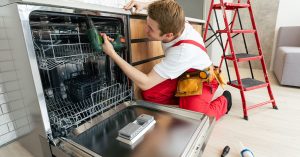Commercial spaces rely on safe and efficient electrical systems to keep operations running smoothly. We know that hidden risks can put both people and property in danger. That is why it is important to understand the most common hazards and how to address them before they cause harm. By focusing on real problems, we can reduce risks and protect our work environments.
Overloaded Circuits
Electricity use in commercial settings is often heavy. Equipment, lighting, and climate systems all draw significant power. When too many devices rely on the same circuit, wires heat up beyond safe limits. As a result, insulation may break down, and the chance of a fire increases. We have seen this happen when businesses expand but fail to update their electrical systems.
To reduce this risk, we should review load distribution regularly. Adding dedicated circuits for high-demand machines makes a difference. Likewise, upgrading panels and breakers ensures the system can handle growth. A professional assessment from a commercial electrical contractor is the best way to confirm capacity and safety before problems develop.
Faulty Wiring and Loose Connections
Another leading hazard comes from wiring that has been damaged, poorly installed, or simply worn out with age. Loose connections cause arcing, where electricity jumps across gaps. This produces heat that can ignite nearby materials. Old or poorly maintained wiring is a hidden danger because it often goes unnoticed until it fails.
We can lower this risk through routine inspections and maintenance. Checking junction boxes, outlets, and panels for heat marks or burning smells is a good habit. Our team also recommends infrared scanning to identify hot spots behind walls or ceilings. Replacing outdated aluminum wiring with copper reduces long-term risk as well.
Inadequate Grounding
Grounding protects people and equipment by directing stray electricity into the earth. If grounding is missing or improperly installed, surges may damage devices or shock anyone who touches metal surfaces. For example, large appliances or HVAC units without proper grounding often fail early or present hidden hazards.
The solution is to confirm that all grounding paths are intact and effective. Using ground fault circuit interrupters (GFCIs) in wet or outdoor areas provides extra safety. In larger facilities, periodic testing of grounding systems ensures they meet standards. Businesses that rely on sensitive electronics especially benefit from proper grounding because it protects equipment from costly damage.
Poorly Maintained Breaker Panels
Breaker panels are the heart of any electrical system. They prevent overloads by shutting down circuits when current levels exceed safe limits. However, if panels are old, damaged, or poorly labeled, they may fail when needed most. In some cases, we have found breakers stuck in the on position, which removes an important layer of protection.
To address this, we should make panel maintenance a priority. Keeping panels free of dust and debris reduces fire risks. Clear labeling also ensures quick response during emergencies. Upgrading outdated panels with modern breaker technology is one of the best investments for long-term safety. This step avoids dangerous faults and makes future expansion easier.
Exposure to Water and Moisture
Commercial buildings often have areas where water and electricity come dangerously close. Kitchens, bathrooms, basements, and outdoor installations are especially vulnerable. Moisture inside outlets or fixtures causes corrosion and increases the chance of shock or short circuits. Flooding or leaks only make this problem worse.
We can manage this by using weatherproof covers and moisture-resistant outlets in vulnerable areas. Installing GFCIs in kitchens and bathrooms is critical. For outdoor wiring, conduit and proper sealing keep water out. Regular checks after storms or leaks prevent hidden damage from becoming dangerous later on.
Improper Use of Extension Cords
Extension cords are useful but not designed for long-term use in commercial environments. Unfortunately, we see them used as permanent wiring too often. Cords may become frayed, overloaded, or placed under rugs and furniture, which increases fire risks. Moreover, cords running across walkways create tripping hazards for employees.
The safest practice is to replace extension cords with permanent wiring. Adding outlets where needed keeps workspaces safer and more efficient. If cords must be used temporarily, they should be rated for the load and kept visible to avoid damage. This small adjustment helps prevent accidents and protects electrical systems from strain.
Outdated Electrical Systems
Many commercial buildings were built before today’s energy demands became the norm. Outdated panels, wiring, and components struggle to keep up with modern requirements. As a result, they overheat, fail more often, and increase the risk of both fires and power outages. Businesses that delay upgrades often face expensive downtime when systems finally break.
The best step forward is a professional evaluation to identify weak points. Replacing panels, upgrading wiring, and installing modern safety devices can extend system life and improve safety. Beyond preventing hazards, modern systems also support energy efficiency. This means fewer interruptions and better long-term savings.
Lack of Preventive Maintenance
Even the best-designed electrical systems fail without regular attention. Dust buildup, loose fittings, and unnoticed wear all contribute to failures over time. In busy commercial settings, minor problems often go unchecked until they become serious. Preventive maintenance is the most effective way to stop this cycle.
We recommend scheduled inspections that go beyond basic checks. Thermal imaging, load testing, and breaker function testing give a clearer picture of system health. Businesses should also train staff to report signs like flickering lights, buzzing outlets, or tripped breakers. These small signs are often early warnings of larger issues.
Human Error and Unsafe Practices
Electrical safety depends on how people use the system. Mistakes such as plugging equipment into the wrong outlets, bypassing safety devices, or storing flammable materials near panels can all lead to serious accidents. We often find that lack of training or awareness is at the core of these issues.
Addressing this risk requires education and consistent rules. Clear labeling of outlets, safe storage policies, and training on basic electrical safety create safer workplaces. Encouraging staff to speak up when they see unsafe practices also helps. When safety becomes part of everyday habits, risks decrease for everyone.
Planning for Future Expansion
Electrical risks often grow when businesses expand without updating their systems. Adding new equipment, computers, or lighting without considering capacity can overwhelm existing infrastructure. As a result, even systems that once were safe become dangerous over time. Growth without planning is one of the most overlooked safety hazards.
The right approach is to plan electrical upgrades alongside business expansion. A system designed with future capacity in mind prevents overloads and avoids costly downtime later. By working with a professional team early, we can design solutions that are both safe and flexible for future needs. That foresight keeps businesses running smoothly.
Emergency Preparedness
Even with strong safety measures, emergencies can still happen. Fires, surges, and outages create dangerous situations if no plan is in place. Employees who do not know where panels are located or how to shut down equipment may panic, which makes accidents worse.
We can improve safety by developing clear emergency response procedures. Staff should know where main shutoffs are and how to use fire extinguishers. Practicing evacuation drills ensures that people react calmly in real emergencies. Keeping emergency contacts posted near panels and phones also provides quick access to help. A prepared team is always safer.
Call to Action
Commercial electrical safety requires planning, regular inspections, and professional expertise. Risks grow when problems go unnoticed or repairs are delayed. Our team can help you address hazards before they become costly or dangerous. If you want expert support, reach out to us today through contact our team and make safety your top priority.
FAQ
What signs show that our electrical system may be unsafe
Look for flickering lights, tripped breakers, burning smells, or warm outlets. These are often early warning signs of deeper problems that require attention.
How often should a commercial electrical system be inspected
Most systems should be inspected at least once a year. However, facilities with heavy usage or older equipment may benefit from more frequent checks.
Are power surges a serious risk in commercial buildings
Yes. Power surges can damage equipment, cause data loss, and lead to costly downtime. Surge protection devices reduce this risk significantly.
What should staff do in case of an electrical fire
The first step is to shut off power if it can be done safely. Then use a Class C fire extinguisher and evacuate the area while calling emergency services.
Can older buildings be made as safe as newer ones
Yes. With proper upgrades such as panel replacements, updated wiring, and modern safety devices, older buildings can meet current safety standards.



